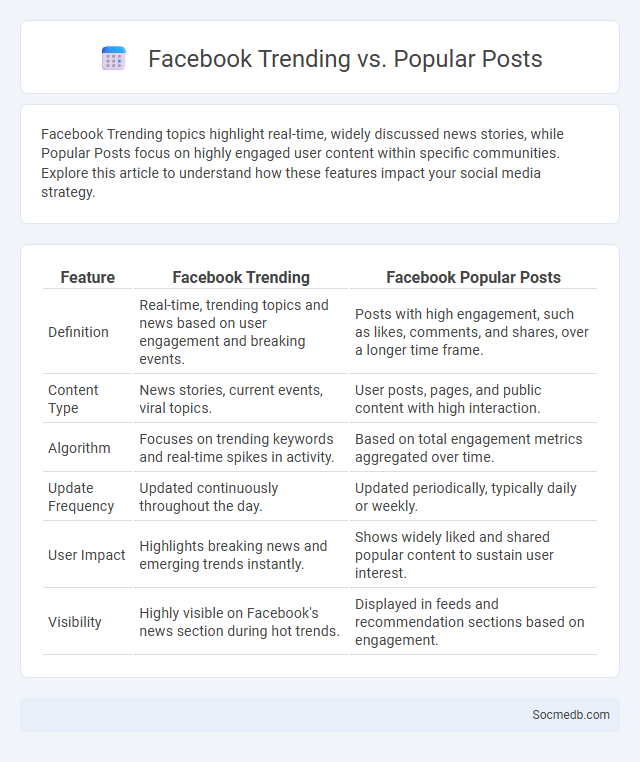
Photo illustration: Facebook Trending vs Popular Posts
Facebook Trending topics highlight real-time, widely discussed news stories, while Popular Posts focus on highly engaged user content within specific communities. Explore this article to understand how these features impact your social media strategy.
Table of Comparison
| Feature | Facebook Trending | Facebook Popular Posts |
|---|---|---|
| Definition | Real-time, trending topics and news based on user engagement and breaking events. | Posts with high engagement, such as likes, comments, and shares, over a longer time frame. |
| Content Type | News stories, current events, viral topics. | User posts, pages, and public content with high interaction. |
| Algorithm | Focuses on trending keywords and real-time spikes in activity. | Based on total engagement metrics aggregated over time. |
| Update Frequency | Updated continuously throughout the day. | Updated periodically, typically daily or weekly. |
| User Impact | Highlights breaking news and emerging trends instantly. | Shows widely liked and shared popular content to sustain user interest. |
| Visibility | Highly visible on Facebook's news section during hot trends. | Displayed in feeds and recommendation sections based on engagement. |
Understanding Facebook’s Trending and Popular Posts Features
Facebook's Trending and Popular Posts features help you identify content that is gaining significant attention across the platform. Trending posts highlight topics with rapid user engagement, while Popular Posts showcase content that consistently receives likes, comments, and shares over time. Understanding these features allows your social media strategy to leverage viral trends and maintain audience interest effectively.
Key Differences Between Trending and Popular Posts on Facebook
Trending posts on Facebook are driven by real-time spikes in engagement and are often tied to current events or viral moments, capturing immediate public interest. Popular posts accumulate steady, high engagement over time, reflecting consistent audience appeal rather than momentary spikes. Algorithmically, Facebook prioritizes trending content to boost visibility during its peak relevance, while popular posts benefit from sustained interactions that signal long-term value.
How Facebook Identifies Trending Content
Facebook identifies trending content by analyzing user interactions such as shares, comments, and reactions to determine what topics are gaining rapid popularity. The platform uses machine learning algorithms to detect spikes in engagement and keywords across posts, pages, and groups to surface timely and relevant stories. Understanding these patterns helps you stay informed about current trends that matter to your interests and network.
The Algorithm Behind Facebook Popular Posts
The algorithm behind Facebook popular posts analyzes user engagement metrics such as likes, comments, shares, and viewing time to determine content visibility. It prioritizes posts that generate meaningful interactions within your network, boosting their reach on newsfeeds. Understanding this algorithm can help you create content that resonates and gains more traction on the platform.
User Engagement: Trending vs Popular Posts
User engagement on social media varies significantly between trending and popular posts, with trending content often driving higher levels of immediate interaction due to its timely relevance and viral nature. Popular posts, characterized by sustained likes, shares, and comments, showcase consistent appeal and long-term audience retention. Analyzing engagement metrics such as click-through rates, time spent, and comment sentiment helps optimize content strategies for maximizing user interaction.
Visibility and Reach: Which Performs Better?
Visibility and reach on social media depend heavily on platform algorithms and content strategy. Instagram's visual-centric format often boosts brand visibility through Stories and Reels, while Facebook's vast user base can enhance organic and paid reach across diverse demographics. Your choice should align with target audience preferences and content style to maximize engagement and conversion.
Content Types that Trend vs What Becomes Popular
Visual content such as videos and images consistently dominate social media trends due to higher engagement rates and shareability. Trending content often includes ephemeral formats like Stories and Reels that capitalize on immediacy and authenticity, while popular posts typically feature evergreen themes such as tutorials, behind-the-scenes insights, and relatable personal experiences. User-generated content and interactive polls also drive popularity by fostering community involvement and trust.
Impact on Brand Strategy: Trending vs Popular Posts
Trending posts often reflect real-time events and viral moments, offering brands a chance to engage with current audience interests and boost visibility. Popular posts, on the other hand, consistently resonate with your target demographic, reinforcing brand identity and long-term loyalty. Your brand strategy should balance leveraging trending content for immediate relevance while cultivating popular posts that build sustained engagement.
Leveraging Insights from Trending and Popular Posts
Analyzing trending and popular posts reveals key audience preferences and content patterns that drive engagement on social media platforms. Leveraging data such as hashtags, post timing, and user interactions enhances targeted marketing strategies and amplifies reach. Utilizing advanced analytics tools helps identify emerging trends, enabling timely content creation that resonates with specific demographics.
Best Practices for Maximizing Both Trending and Popular Content
To maximize both trending and popular content on social media, focus on timely engagement by analyzing current hashtag trends and user interests. Optimize your posts with targeted keywords, high-quality visuals, and concise captions that encourage interaction from your audience. Ensure your content is shareable and tailored to platform-specific algorithms to enhance visibility and reach.
 socmedb.com
socmedb.com